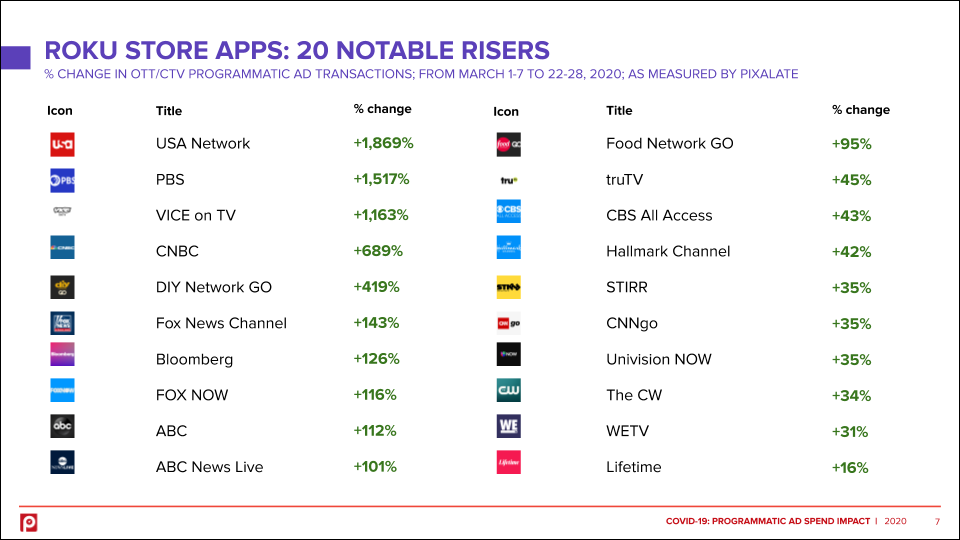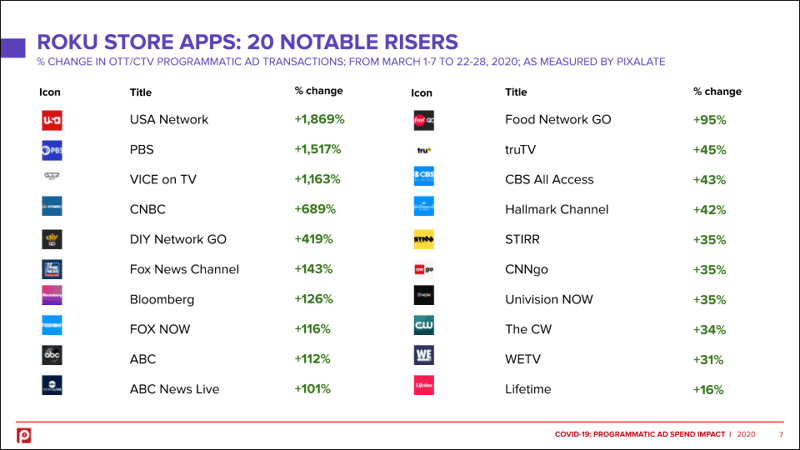
In Pixalate's latest special report, Programmatic Ad Spend in the Age of COVID-19: Connected TV/OTT Advertising, we examine how OTT/CTV advertisers have adjusted ad spend in the face of a global crisis.
While overall programmatic OTT/CTV ad spend decreased 14% in March, certain apps saw big jumps in demand.
Note: Pixalate is using programmatic ad transactions as a proxy for ad spend for this research.

PBS, the Public Broadcasting Service featuring music, the arts, and news analysis, saw a 1,517% increase in programmatic ad spend, comparing the first full week of March (March 1-7) to the last full week (March 22-28).
Other notable risers:
See the chart above to see 20 notable risers.
What's inside the report
Pixalate's Programmatic Ad Spend in the Age of COVID-19: Connected TV/OTT Advertising report includes:
Download a free copy of the Programmatic Ad Spend in the Age of COVID-19: Connected TV/OTT Advertising report today.
Disclaimer
The content of this blog, and the Programmatic Ad Spend in the Age of COVID-19: Connected TV/OTT Advertising report (the "Report"), reflect Pixalate's opinions with respect to the factors that Pixalate believes can be useful to the digital media industry. Any proprietary data shared is grounded in Pixalate's proprietary technology and analytics, which Pixalate is continuously evaluating and updating. As cited in the Report and referenced in the Report's key findings reproduced herein, programmatic ad transactions, as measured by Pixalate, are used as a proxy for ad spend. The Report examines U.S. advertising activity. Any references to outside sources in the Report and herein should not be construed as endorsements. Pixalate's opinions are just that, opinions, which means that they are neither facts nor guarantees.
*By entering your email address and clicking Subscribe, you are agreeing to our Terms of Use and Privacy Policy.
These Stories on CTV
*By entering your email address and clicking Subscribe, you are agreeing to our Terms of Use and Privacy Policy.

Disclaimer: The content of this page reflects Pixalate’s opinions with respect to the factors that Pixalate believes can be useful to the digital media industry. Any proprietary data shared is grounded in Pixalate’s proprietary technology and analytics, which Pixalate is continuously evaluating and updating. Any references to outside sources should not be construed as endorsements. Pixalate’s opinions are just that - opinion, not facts or guarantees.
Per the MRC, “'Fraud' is not intended to represent fraud as defined in various laws, statutes and ordinances or as conventionally used in U.S. Court or other legal proceedings, but rather a custom definition strictly for advertising measurement purposes. Also per the MRC, “‘Invalid Traffic’ is defined generally as traffic that does not meet certain ad serving quality or completeness criteria, or otherwise does not represent legitimate ad traffic that should be included in measurement counts. Among the reasons why ad traffic may be deemed invalid is it is a result of non-human traffic (spiders, bots, etc.), or activity designed to produce fraudulent traffic.”

